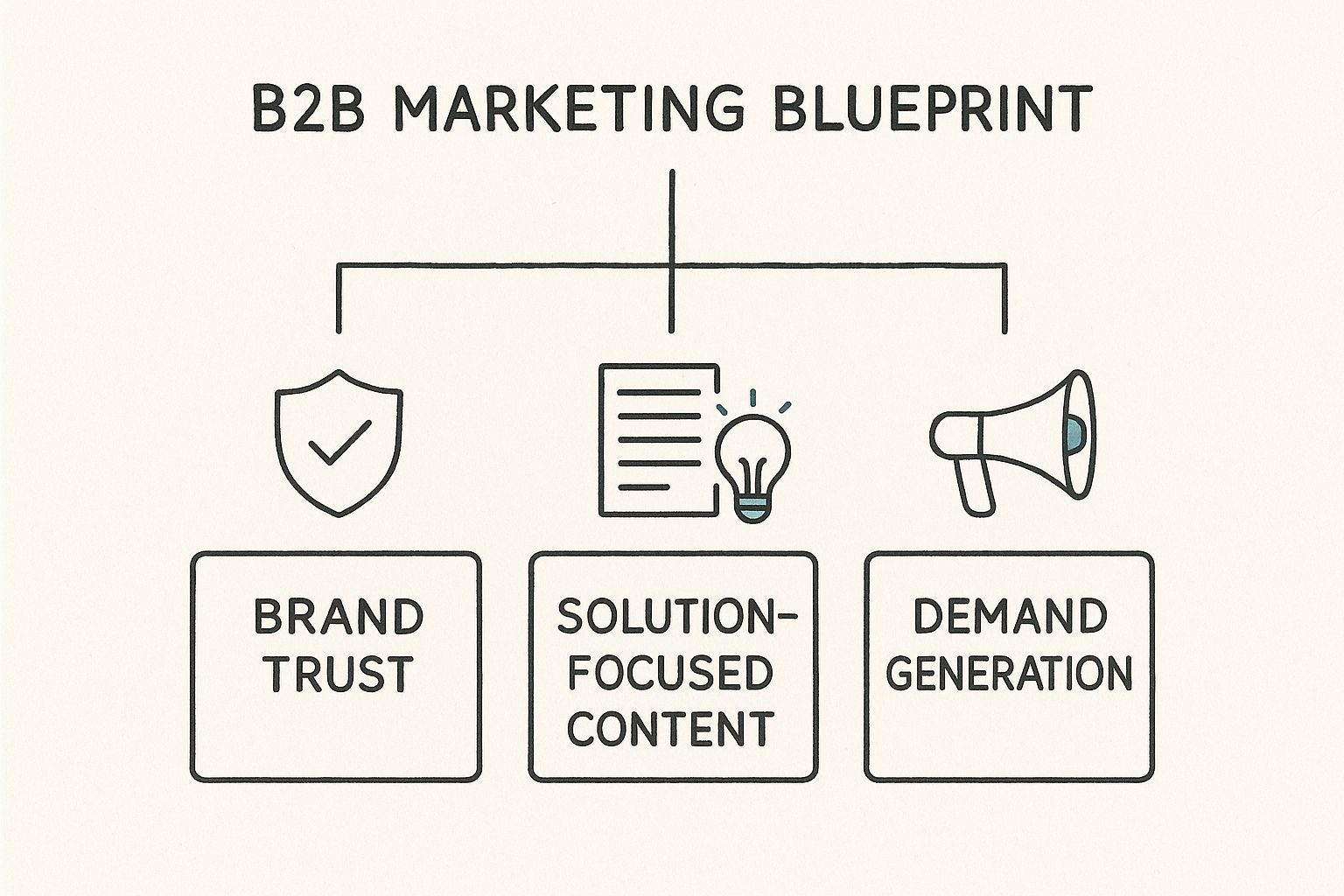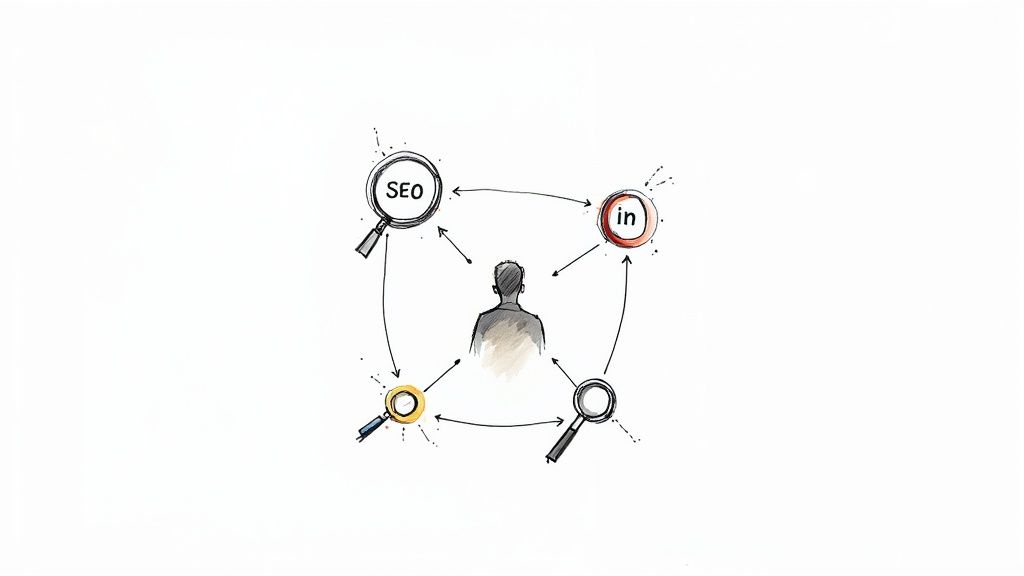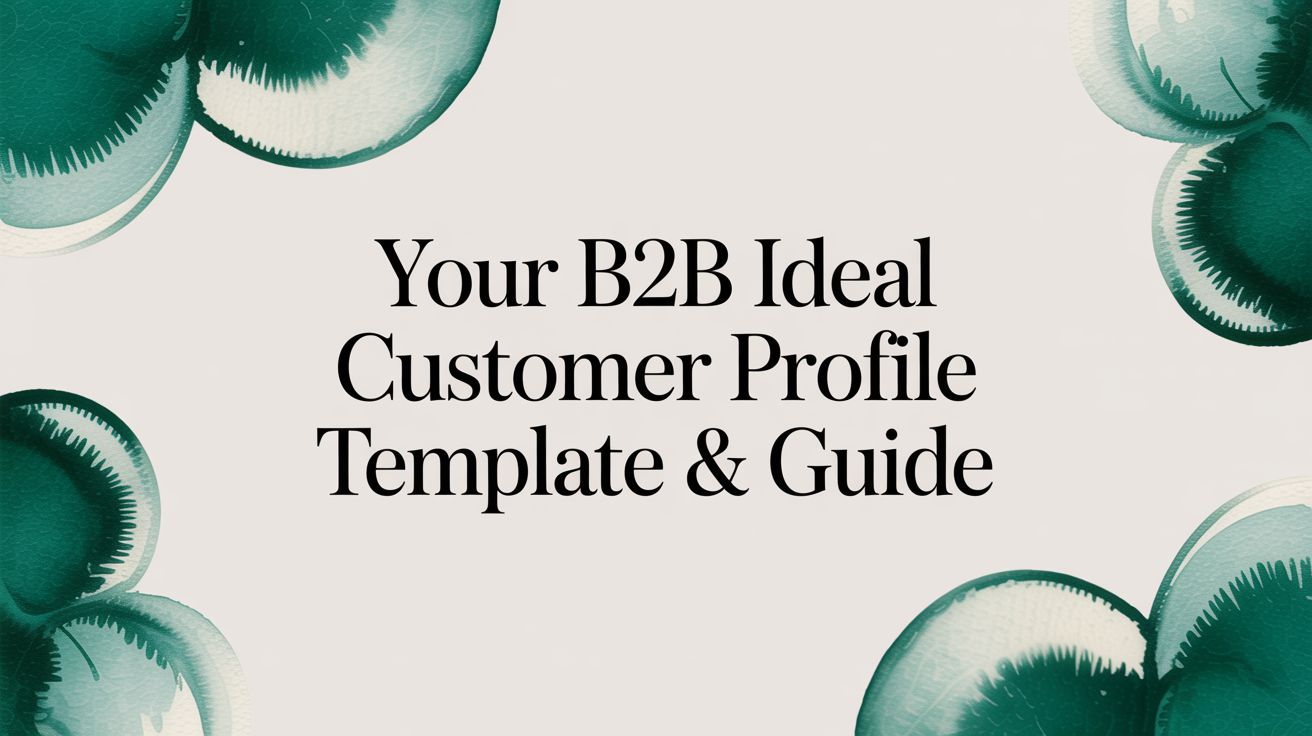Effective B2B Marketing Approach for Tech & SaaS
October 17, 2025

A solid b2b marketing approach isn't about chasing the latest shiny object; it’s about architecting a clear, revenue-focused blueprint. It’s the shift from abstract goals to a tangible strategy where every single action directly supports sales and growth.
Building Your B2B Marketing Blueprint
The real foundation of modern B2B marketing is a fundamental shift in mindset. Instead of treating marketing like a separate cost center, leading companies see it as a direct contributor to the sales pipeline. Every campaign, piece of content, and social media post has a purpose tied directly to revenue.
Think of it like an architect's plan for a skyscraper. Every element is intentionally placed, from the deep foundations of brand trust to the high-visibility spire of demand generation. They all work in concert to support the entire structure, ensuring it remains stable as it grows. A strong blueprint aligns every marketing activity into one cohesive system.
This integration is more critical than ever. Today’s B2B buyer is assessing your brand’s credibility and your solution’s fit at the same time. By 2025, performance-driven strategies will be the norm, with all marketing efforts calibrated to support sales outcomes and reflect the digital-first nature of the modern buying journey.
The Core Components of Your Blueprint
To build a plan that actually works, you have to integrate three core functions. Each plays a distinct but interconnected role in guiding buyers through their decision-making process. These aren’t separate silos—they're gears in a single, powerful engine.
- Brand Trust: This is your foundation. It’s built through consistent messaging, genuine thought leadership, and, most importantly, delivering on your promises. Trust is what convinces potential customers you're a credible partner worth their investment.
- Solution-Focused Content: This is how you prove your value. Instead of just listing features, your content must solve real-world problems for your target audience, demonstrating your expertise and deep understanding of their challenges.
- Demand Generation: This is the engine that drives qualified leads. It covers all the activities that capture interest and pull potential buyers into your sales funnel, turning awareness into real, actionable opportunities.
This diagram shows how these three pillars form the structure of your marketing blueprint.

As you can see, brand, content, and demand generation aren't sequential steps. They are parallel efforts that constantly reinforce one another. A strong brand makes your content more believable, and valuable content is the fuel for your demand generation campaigns.
To give this concept more structure, here’s a look at how these pillars have evolved from traditional marketing thinking to a modern, revenue-focused approach.
Core Pillars of a Modern B2B Marketing Approach
This table highlights the crucial shift from activity-based metrics (like impressions) to outcome-based metrics that directly tie marketing efforts to the bottom line. It's not just about being busy; it's about making an impact.
A well-crafted blueprint ensures you're not just creating noise; you're building a predictable system for growth. It transforms marketing from a series of random acts into a strategic function that delivers measurable results.
Of course, creating this plan requires careful thought and documentation. For a deeper dive into structuring this foundational document, check out our guide on how to write a marketing plan. It will help you translate these concepts into an actionable strategy for your own business.
The Three Pillars of a Winning B2B Strategy
A powerful B2B marketing approach doesn’t just happen—it's built on a foundation of deliberate, interconnected strategies. Think of it like a three-legged stool. If you take one leg away, the whole thing comes crashing down. The same goes for your marketing. Real, sustainable success rests on the balanced execution of three core pillars.

These pillars don't work in isolation. They're not a sequence of steps you follow one after the other. Instead, they're parallel efforts that constantly feed into and strengthen one another, transforming your marketing from a series of disjointed tasks into a powerful engine for winning high-value customers.
Let's break each one down.
Pillar 1: Account-Based Marketing
Account-Based Marketing (ABM) is all about precision. Forget casting a wide net and hoping for the best. With ABM, you treat individual high-value accounts as their own unique markets. It's the difference between using a shotgun and a sniper rifle—you're focusing all your resources on the companies that will make the biggest impact on your bottom line.
This is where sales and marketing absolutely have to be joined at the hip. Together, they pinpoint the key accounts you want to land. From there, they build hyper-personalized campaigns engineered to solve the specific challenges and speak to the unique goals of that single organization. It's this laser focus that allows your message to cut through the noise and land directly with decision-makers.
Of course, you can't hit a target you haven't defined. A crucial part of this process is understanding your ideal customer profile. To learn more about identifying and grouping your best-fit customers, explore our guide to https://www.bigmoves.marketing/blog/b-2-b-market-segmentation.
Pillar 2: Authoritative Content Marketing
If ABM is the targeting system, content is the fuel for your entire marketing engine. In the B2B world, content isn't just about getting clicks; it’s about building authority and earning trust. Your content has to solve real-world problems and answer the tough, specific questions your prospects are wrestling with every day.
The goal is to become the most helpful, insightful expert in your field. This pillar is about creating things like:
- In-depth articles that don't just skim the surface but dive deep into industry challenges and offer up practical, actionable solutions.
- Original research and reports that provide unique data points and position your company as a true thought leader.
- Case studies and success stories that serve as tangible proof, showing exactly how your solution delivers real value.
When your content consistently delivers value, you stop chasing buyers and start attracting them. They seek you out because you have proven you understand their world and can help them succeed.
Pillar 3: Consistent Demand Generation
Demand generation is the machine that takes all the interest and authority you've built and turns it into a steady, predictable flow of qualified leads. This pillar covers all the activities you use to capture and nurture potential customers until they're genuinely ready for a conversation with your sales team.
This isn't just about collecting email addresses. It's about building a pipeline you can count on. Effective demand gen relies on a multi-channel approach—everything from SEO and paid media to webinars and email nurturing—to engage buyers at every single stage of their journey. The goal is to create constant awareness and interest, ensuring your sales team always has a healthy list of prospects to talk to.
As you define the core pillars of your B2B marketing strategy, you can explore these 10 B2B SaaS Marketing Strategies to Win for more actionable approaches tailored to tech businesses.
Mastering the Digital Channels That Matter Most
Your customers are deep into their research, evaluation, and decision-making process online long before they ever think about talking to a sales rep. An effective B2B marketing strategy doesn't fight this reality—it leans into it, meeting buyers exactly where they are.
This means transforming your digital channels from simple broadcasting tools into platforms for genuine connection and influence. Being discoverable isn't just a nice-to-have anymore; it's the price of entry.

Mastering these channels is all about creating a digital footprint that feels both omnipresent and genuinely helpful to your ideal buyers. It's making sure your message is clear, compelling, and consistent, whether a prospect finds you through a Google search, a professional network, or on their phone during their morning commute. This strategic presence builds the credibility you need at every single touchpoint.
Prioritizing Your Digital Strategy
Let's be clear: not all channels are created equal, especially in the B2B world where buying cycles are long and the decisions are anything but simple. Spreading yourself too thin is a recipe for mediocrity. A focused approach on the right platforms will always yield better results than trying to be everywhere at once.
The key is to concentrate your energy where it will make the biggest impact. For any modern B2B brand, these channels are non-negotiable:
- Search Engine Optimization (SEO): This is so much more than just keywords. It’s about building authority and becoming the definitive, trusted answer when your prospects ask questions online. Strong SEO ensures you’re visible during the critical research phase of their buying journey, positioning you as the expert from the very beginning.
- A Strong LinkedIn Presence: This platform is the undisputed digital town square for B2B professionals. A well-managed LinkedIn page isn't just for company updates; it’s a powerful engine for building relationships, establishing thought leadership, and engaging directly with the decision-makers you need to reach.
- Flawless Mobile Optimization: B2B buying doesn't just happen at a desk from nine to five. Your buyers are researching solutions on their phones and tablets, and your website and content must deliver a perfect experience on any device. Anything less is a dead end.
The Power of Professional Networks and Mobile
The digital behavior of B2B buyers has shifted dramatically, and the data tells a compelling story. When it comes to lead generation from social media, LinkedIn isn't just a player—it's the entire game, delivering an incredible 80% of B2B leads that originate from social channels.
A robust presence here is vital. If you're not already, start by optimizing your LinkedIn Company Page to maximize your outreach and engagement.
The goal isn't just to be present online; it's to be present with purpose. Every channel should serve a specific role in guiding your audience from awareness to consideration and, ultimately, to a confident purchase decision.
At the same time, mobile devices have become absolutely central to the buying process. Nearly half of all B2B advertising spend is projected to be on mobile platforms by 2025, which tells you exactly where the attention is focused. Today, around 60% of B2B buyers use their mobile devices to research products, and they demand fast, intuitive digital experiences.
By mastering these platforms, you create a cohesive digital experience that meets your buyers where they are. To get a comprehensive overview of how different platforms can work together, check out our deep dive into the top B2B channels. This ensures your marketing isn't just visible, but truly influential.
Integrating AI to Enhance Your Marketing Efforts
Let's be clear: artificial intelligence isn't some far-off concept from a sci-fi movie anymore. It's a practical, powerful tool that can seriously amplify your B2B marketing, and it’s already here. The key is to stop thinking of AI as a replacement for human creativity and start seeing it for what it truly is—a ridiculously smart assistant that handles the grunt work and uncovers insights buried deep in your data.
This frees up your team to focus on what they do best: high-level strategy, real innovation, and building genuine customer relationships.

Think of AI as a force multiplier, especially for personalization. Forget about blasting out generic emails to your entire list. AI-powered tools can sift through customer data to tailor your outreach at a scale that was previously impossible, making every single prospect feel like you're speaking directly to them. This kind of automation isn't just about efficiency; it's about delivering a fundamentally better experience.
And this isn't just a trend on the horizon. The shift is happening now. By 2025, AI is expected to be a core component of most B2B marketing stacks. We're already seeing 34% of B2B buyers in sectors like manufacturing and healthcare using AI to automate tasks. Another 32% are using AI tools to help scale up their content creation without sacrificing quality. You can dig into more of this data in these B2B marketing trends on gwi.com.
Finding the Right Balance with AI
While the potential of AI is immense, diving in without a strategy is a recipe for disaster. The goal is not to automate everything. It's to strategically use technology to liberate your team's talent for higher-value work. Your team's expertise in understanding nuance, building trust, and making the final call on strategy is, and always will be, irreplaceable.
Here are a few practical ways you can apply AI without losing that essential human element:
- Automating Lead Scoring: AI algorithms can analyze prospect behavior—website visits, content downloads, email opens—to pinpoint the hottest leads. This lets your sales team focus their energy where it will have the biggest impact.
- Personalizing Content Delivery: Based on a visitor's browsing history and company data, AI can dynamically recommend the most relevant blog posts, case studies, or whitepapers, creating a journey that feels unique to them.
- Optimizing Ad Campaigns: Instead of manually tweaking campaigns, machine learning models can adjust ad spend and targeting in real-time to squeeze the maximum return out of every dollar you spend.
The smartest B2B marketers are using AI to handle the scale and complexity of data, which in turn empowers them to be more creative and strategic. It’s about making your team faster and more effective, not replacing them.
Maintaining Trust in an AI-Driven World
As you weave more AI into your marketing, being transparent with your audience is non-negotiable. People have valid concerns about data privacy and security, and you need to address them head-on.
Be crystal clear about how you're using customer data. Ensure your AI tools are used ethically to support your customers, not to manipulate them. For a much deeper dive on this topic, our CMO's guide to integrating generative AI in B2B marketing is packed with practical advice.
At the end of the day, technology is just a tool. The human touch—empathy, understanding, and genuine connection—remains your most valuable asset in building lasting B2B relationships.
Measuring Success Beyond Surface Level Metrics
An effective B2B marketing approach isn't judged by website traffic or social media likes. Those surface-level numbers are easy to track, but they reveal next to nothing about what actually matters—revenue. The most inspiring marketing teams I’ve seen operate as profit drivers, and they do it by speaking the language of the C-suite.
To get there, you have to shift your focus from those vanity metrics to the key performance indicators that draw a straight line from marketing activities to financial outcomes. These are the numbers that tell a powerful story of growth, efficiency, and return on investment.
The Metrics That Define Your Impact
The true measure of your B2B marketing success really just boils down to a handful of core metrics. Mastering these will completely transform how your department is perceived, moving it from a cost center to a critical growth engine.
Here are the essentials you need to nail down:
- Customer Acquisition Cost (CAC): This is the total cost of your sales and marketing efforts to acquire a single new customer. A lower CAC is a clear sign of an efficient marketing machine.
- Customer Lifetime Value (LTV): This metric represents the total revenue a business can reasonably expect from a single customer account over time. A high LTV means you're not just finding customers; you're attracting and keeping the right ones.
- Marketing-Influenced Pipeline: This number shows the total value of sales opportunities that marketing has generated or even just touched. It’s the proof of your direct contribution to future revenue.
The most powerful story you can tell is one where every dollar invested in marketing generates multiple dollars in return. The ideal ratio is an LTV that is at least three times your CAC.
Tracking these numbers creates a clear narrative that connects your budget directly to bottom-line results. For a detailed guide on getting this set up, you can learn more about how to measure marketing success for data-driven B2B growth in our dedicated article. This kind of strategic measurement is the final, crucial piece of a truly sophisticated b2b marketing approach.
Putting It All Together: Your Action Plan for B2B Marketing Success
Alright, enough theory. Strategy is critical, but it's action that builds momentum and, more importantly, drives revenue. This is where the rubber meets the road—where we take all the pillars, channels, and measurement frameworks we’ve discussed and forge them into a cohesive, actionable plan.
Let's make this real. Imagine a brand-new B2B SaaS startup. They’ve just shipped an innovative project management tool designed specifically for remote engineering teams. Their big goal? Land their first 50 paying customers in the next six months.
Setting Goals and Marshalling Resources
First things first, they get specific. “Growth” is not a goal; it’s a wish. Their objective is clear, measurable, and time-bound: 50 customers in six months. That single piece of clarity will guide every decision they make from here on out.
Next up is the budget. With a clear target, they can work backward to figure out a realistic Customer Acquisition Cost (CAC) they can live with. As an early-stage company, this means getting scrappy and focusing on channels that deliver the most bang for their limited buck.
Here’s what their initial allocation looks like:
- Content Marketing: They’ll write in-depth blog posts that directly compare their tool against the established players, hitting on the precise pain points engineering managers complain about.
- LinkedIn Outreach: A small, dedicated budget is carved out for hyper-targeted ads aimed squarely at decision-makers who fit their ideal customer profile.
- SEO Foundation: They’ll put in the sweat equity to get their on-page SEO right for their core website pages. This is a long-term play, but the foundation needs to be solid from day one.
Launching an Integrated Campaign
With their goals defined and budget in place, they don’t just launch a bunch of separate tactics—they launch an integrated campaign. Each piece is designed to support the others. The blog content becomes fuel for their social media, gives them something valuable to share in their email newsletter, and provides the perfect destination for their LinkedIn ads.
The real magic of an action plan isn't in its complexity, but in its coherence. Every single piece should work in concert, creating a unified force that guides potential customers from simply being aware of you to actively choosing you.
This startup now has a clear roadmap, not just a collection of ideas. They can track where leads are coming from, measure how well each channel converts, and shift their spending based on what the data tells them is working. This constant cycle of planning, executing, and measuring is what turns an abstract strategy into a predictable engine for growth.
Frequently Asked Questions About B2B Marketing
Even the sharpest B2B marketing plans run into tricky questions. When you're in the trenches, navigating the day-to-day of a tech or SaaS startup, specific challenges pop up that demand clear, practical answers. This section tackles some of the most common questions I hear from founders and marketing leaders.
The goal here isn't to give you generic advice but to offer insights you can actually use to sidestep common hurdles. From figuring out your budget to getting sales and marketing on the same page, these answers are designed to bring clarity to your strategy and give you the confidence to execute.
How Much Should a B2B SaaS Startup Spend on Marketing?
There’s no magic number that fits everyone, but a solid benchmark for a growth-focused SaaS company is to earmark 20% to 40% of annual recurring revenue (ARR) for marketing. This is especially true in the early days when you're fighting for brand awareness and market position.
But honestly, the real answer comes down to your goals. A startup gunning for aggressive market capture is going to invest a lot more than an established player focused on steady, predictable growth. The key is to anchor your budget to your revenue targets and what you know about your Customer Acquisition Cost (CAC), not just some arbitrary percentage.
What’s the Most Overlooked Aspect of B2B Marketing?
Hands down, it’s team alignment. A brilliant strategy is worthless if your sales and marketing teams are operating on different planets. When marketing has no clue about real-world sales objections and sales ignores the content marketing painstakingly creates, you're just burning cash.
The most successful B2B marketing organizations are obsessed with communication. Marketing should be a fly on the wall during sales calls, and sales needs to give direct, unfiltered feedback on lead quality and campaign messaging. This isn't about two separate functions; it's about building a single, powerful revenue team.
How Long Until We See Results from Our B2B Marketing Approach?
Patience isn't just a virtue in B2B marketing; it's a strategic advantage. This isn't e-commerce, where a flash sale can deliver instant results. B2B sales cycles are long, and it takes time to build the trust needed to guide a prospect through a complex buying journey.
For foundational strategies like content marketing and SEO, you should expect to see meaningful traction within 6 to 9 months. Think of these as long-term investments in your company's authority and credibility. For more direct tactics like targeted ad campaigns or account-based marketing, you might see initial leads pop up in a few weeks, but turning those leads into paying customers will still take as long as your typical sales cycle.
The real impact of your efforts is measured in quarters, not days.
Ready to build a B2B marketing approach that drives real revenue? At Big Moves Marketing, I partner with B2B SaaS and AI startups to develop the positioning, sales tools, and launch strategies that win deals. Let's build your go-to-market plan.
%20-%20Alternate.svg)


%20-%20white.svg)